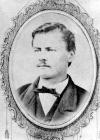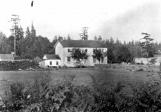14
Captain George Greenwood, sailmaker for the 'Jessie' at Craigflower19th Century, circa 1870
Craigflower, View Royal, Victoria, Canada
 Credits:
Credits:G-02364
16
First residence at Craigflower Farm19th Century, Circa 1938
Craigflower, View Royal, Victoria, Canada
 Credits:
Credits:A-02930
17
The abandoned bakehouse at Craigflower Farm20th Century, 1931
Craigflower, View Royal, Victoria, Canada
 Credits:
Credits:A-02940
18
Dick Berlin, the baker at Craigflower farm from 1853 until 1858.19th Century, Circa 1870
Craigflower, View Royal, Victoria, Canada
 Credits:
Credits:G-02255
19
Craigflower farm labourers residences.20th Century, 1931
Craigflower, View Royal, Victoria, Canada
 Credits:
Credits:A-02942
20
Craigflower farm, bakehouse is the stone building in the background.20th Century, 1931
Craigflower, View Royal, Victoria, Canada
 Credits:
Credits:A-02943
21
Craigflower farm buildings up close, bakehouse is the stone building in the center.20th Century, 1931
Craigflower, View Royal, Victoria, Canada
 Credits:
Credits:A-02941
22
McKenzie's first residence at Craigflower19th Century, circa 1860
British Columbia Archives
 Credits:
Credits:A-01438
23
Craigflower Manor, or farmhouse it was then known was completed in 1856 to look like a facsimile of Renton Hall, the McKenzie's home in Haddington, Scotland. Renton Hall was a Georgian mansion, built in the eighteenth century. Although Renton Hall was constructed using quarried stone, wood was a more plentiful and accessible resource and was used for Craigflower Manor. The first floor of the building was constructed using the traditional tongue and groove Hudson's Bay method of construction. For the second floor of the building, a stud frame method was used. This difference may have possibly meant that the house was only originally intended to be a one story high structure.The whole farm took its name from the Governor of the Hudson's Bay Company, Andrew Colville's, estate in Scotland. The original Craigflower estate in Scotland is now a golf course! Craigflower in Gaelic means "Hill of Flowers."
25
Robert Melrose in his diary wrote a detailed account of the life at Craigflower farm during its first five years. His record keeping has allowed many historians to learn about the early life of the settlers at Craigflower. He wrote about all of the births of the children at Craigflower and the surrounding area, although ironically his own daughter, Ellen Melrose's birth was not recorded.One of the areas of the diary, which now causes some amusement was his recording of how drunk the people on Craigflower were at work or later in the evenings. He generally evaluated how drunk people were, on a quarterly scale of drunkeness, ranging from a quarter to fully drunk. Melrose did not exclude himself or his boss, Kenneth McKenzie, either. They were both noted in his diary, the same as everyone else.
27
Henry Weir, who was reported to have been a carpenter for the Hudson's Bay Company aboard the Norman Morison , came to Craigflower Manor to build the farmhouse's interior staircase banister was made out of Arbutus wood. Arbutus trees (arbutus menziesii) only grow within two miles of a large salt water source, which is the Pacific Ocean. This tree only grows in the Southern hemisphere and on the Northwest Coast of North America.The wood is very hard to cut through, especially with pioneer manual tools and to the recently arrived Scotsmen, it would be an unfamiliar wood, and as Weir would have quickly found out, the wood's difficult nature. Arbutus must be carved into small pieces, and then attached together from the separate pieces. The Arbutus was probably chosen for its beauty and the quantity of it found on the site. Weir finished the banister on maple posts, and this banister is still standing today. The McKenzie children used to consider it their part in the dusting of the house by sliding down the banister in order to keep it shiny!
As well as the banister, Weir also built all of the window frames for the farm house.
The story opposite was written by Henry Weir, about his early adventures in Victoria and down the coast to Fort Nisqually. In this story, read by his great- granddaughter, Joan McIlwyn-Cleghorn, Henry's sense of adventure and humour come through, and it gives a good idea of how rustic Victoria was when the McKenzie's first arrived.


